Figure 1 “In addition, the insulation had to be economical and light in weight so the kiln would not exceed its load limit and tax the kiln supports and drive system.” (The light weight would also facilitate handling, resulting in easier installation.) Several fiber-based boards were considered, but none had the crush-resistance of Marinite I and P insulation. A foreign-made insulation was also investigated, but not used because it required a thickness more than two times that of Marinite to provide the same insulating capability. That extra thickness would reduce the kiln volume and throughput, and result in higher weight, which would 1. The cold rolled steel kiln shell was prepared prior to application of the insulation. First. it was cleaned of all dirt and debris. Then, where the shell was out of round or partially oxidized, depressions were filled in with mortar. Figure 2 Figure 4 Figure 3 Figure 5 Denver Billerica ZelienopleLime Kilns Cut Gas Costs by $200,000 per Year with Marinite Insulation
Products: Marinite I; Marinite P
Industry: Pulp & Paper
Application: Rotary Kiln Insulation
The insulation requirements were stringent.
TRP&P’s corporate process engineer was “looking for several qualities in the insulation. The ideal material would possess a thermal conductivity low enough to justify the cost of the insulation: crushing strength, or modulus of rupture, at least 1200 psi in the hotter zones, and at least 800 psi in the colder ones; and the ability to withstand temperatures of at least 800°F at the brick/insulation interface in the burn zones, and l000°F in
the cooler areas.”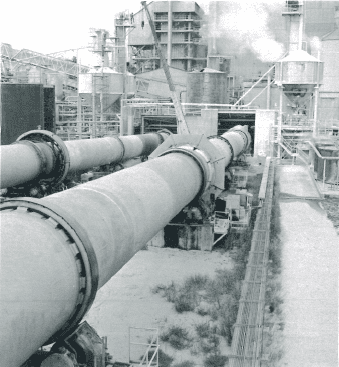
A thorough evaluation of insulation alternatives.
In its search for an insulation that would meet these multiple requirements, over one-half dozen materials were evaluated.
push a kiln over its load-carrying limit .
Marinite installation was customized for each kiln zone.
TRP&P’s two kilns measure 9′ ID x 250′ long, and
10 1/2′ ID x 270′ long. In each kiln, temperatures range from 2500°F in the burn zone to 300°F at the charge end. The kilns operate continuously for several months at a time. The Marinite was installed between the refractory brick and shell when worn bricks were being replaced during regularly-scheduled maintenance shutdowns. Factory pre-cut into 4″ x 4′ strips from 4′ x 8′ panels,
Marinite was laid in place without any adhesive. After a 4′ section was placed, liner brick was installed over it in normal fashion.
Marinite I and P were used in 170 lineal feet of each kiln. At the charge end. where temperatures can be as low as 300°F each kiln contains a 95′ to 100′ long section of 1′ thick Marinite I placed behind 70% alumina refractory brick.
Following the Marinite I installation is a section containing approximately 35′ of 1′ thick Marinite P, where brick hot face temperatures range from 1300°F to 1800° F.
The next segment, just before the burn zone, where temperatures rise to 2000°F is a short section (18′ and 13′ kilns 1 and 2, respectively) of 1/2″ thick Marinite P, all behind the alumina brick.
In the burn zone. where temperatures peak at 2500°F basic brick is used with no insulation because the interface temperatures would be too high for the Marinite.
From the end of the burn zone to the discharge outlet ( 18′ and 27′ in the two kilns , respectively), l/2″ Marinite P backs up the alumina brick.
Narrower thicknesses of Marinite are used in the hotter kiln zones to avoid brick and insulation interface temperatures above 1800°F.
The energy savings from Marinite insulation become even more significant as the brick wears down. In the burn zone, the difference between new 6″ brick with no insulation and new 6″ brick backed by 1/2″ Marinite P is approximately 1200 Btu/ft2/hr in savings.
This contrasts sharply with the difference between worn 3″ brick with no insulation and worn 3″ brick backed by 1/2″ Marinite P, which showed a savings of 2800 Btu/ft2/hr.
The heat loss reduction achieved by Marinite behind worn brick is almost 2 1/2 times greater than with the new.
5-month paybacks, and more.
Since installation. Marinite I and P have provided a heat-loss reduction totaling more than 6.3 million Btu/hr, with combined savings of more than $200.000 per year in natural gas costs, 5-month paybacks and returns on investment of 228% and 255%.
Because of their high thermal insulating values and good mechanical strength. Marinite I and P insulating boards have met the requirements of Tennessee River Pulp & Paper. and continue to function well in both kilns.Application Procedure
2. Next. factory pre-cut 4 ‘ x 4’ strips of Marinite structural insulating board were laid in place dry, without adhesive, on the cleaned surface . Although the Marinite was pre-cut for on-the-job efficiency, it was also easily cut on site, as needed.
Beginning at the very bottom o f the shell – at 6 o’clock – the boards were laid up both sides to 3 and 9 o’clock. Where welds or bolts were in the way, the Marinite was grooved with a bricklayer’s scotch to fit over the irregular surface.
4. With the bottom half of the shell completed , a jig was moved into position, and one row of kiln liner brick was put loosely into place. Then Marinite boards were slid between brick and shell surface.
5. Finally, the jig was tightened, and key brick and board were inserted, assuring a tight seal. Additional rows of brick were added to complete one 4′ long section.
6. With one 4′ long section completed, the whole process was repeated in the next 4′ section, and then the next, until the entire shell was insulated.
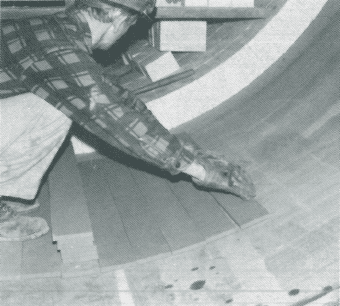
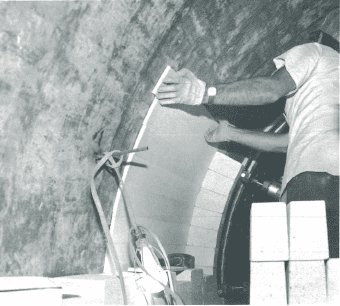
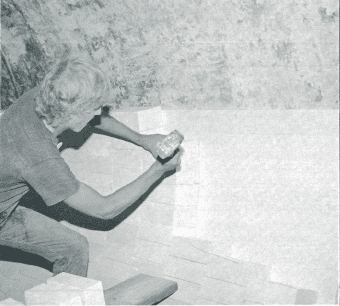
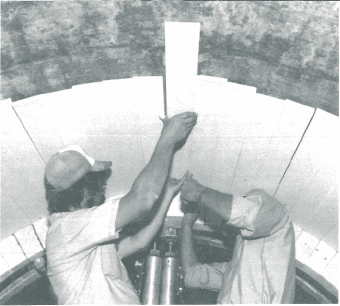
Warranty
Limitation of Liability
THAN THE LIMITED LIABILITY SET FORTH ABOVE.
Corporate Headquarters
6901 South Pierce Street
Suite 260
Littleton. CO 80123
Phone: (303) 978-1199
Fax: (303)978-0308Marinite Plant Location
High Street
Iron Hourse Park
North Billerica, MA 01862
Phone: (508)663-3401
Fax: (508)663-2735Other Plant Locations:
Front Street
P.O. Box 190
Zelienople, PA 16063
Phone: (412)452-8650
Fax: (412)452-1346
Lime KilnsBNZ Materials2020-02-25T00:06:48+00:00
Tennessee River Pulp & Paper, Counce, TN, has two gas-fired kilns which were built in 1962 and 1975, and which were not insulated at the time. These lime kilns, integral components of the kraft mill causticizing cycle, burn calcium carbonate to create calcium oxide, or lime, for reuse in the pulping process. If the kilns fail, mill production comes to a halt. Thermal insulation of the kilns would not have been cost-effective at the time they were built, because energy costs were relatively low. When the reduction of fuel consumption became of prime importance, insulation of these kilns was vital to cost-efficient operations, because controlling heat loss lowers fuel costs.
Marinite I and P came closest to meeting the “ideal” structural insulation requirements. Formed from calcium silicate, with inert fillers and reinforcing agents, these boards provide high thermal insulating values at light weight and density, with good crush resistance under brick load, and ease of installation. The high compressive strength of the Marinite board allows for a tighter lining and longer brick life than a more compressible material would provide.
Due to its ease of installation. Marinite had a negligible affect on the total time needed to rebrick the kilns.
Marinite energy savings go up as the brick wears down.
3. Kiln liner brick was then installed in normal fashion over the Marinite between 3 and 9 o’clock on the shell. Installation on the whole bottom half of each 4′ section of the shell (equal to the length of the Marinite strips) was completed first.
BNZ Materials warrants that its products are manufactured in accordance with its applicable material specifications and are free from defects in workmanship and materials using BNZ’s specifications as a standard. Every claim under this warranty shall be deemed waived unless in writing and received by BNZ within thirty (30) days of the date the defect was discovered and within one (1) year of the date of the shipment of the product.
BNZ MAKES NO OTHER REPRESENTATION OR WARRANTY OF ANY KIND, EXPRESS OR IMPLIED, IN FACT OR IN LAW, INCLUDING WITHOUT LIMITATION, THE WARRANTY OF MERCHANTABILITY OR THE WARRANTY OF FITNESS FOR A PARTICULAR PURPOSE, OTHER THAN THE LIMITED WARRANTY SET FORTH ABOVE.
It is expressly understood and agreed that the limit of BNZ’s liability shall be the resupply of a like quantity of non-defective product and that BNZ shall have no such liability except where the damage or claim results solely from breach of BNZ’s warranty.
IT IS ALSO AGREED THAT BNZ SHALL NOT BE LIABLE FOR ANY INCIDENTAL, CONSEQUENTIAL, OR OTHER DAMAGES FOR ANY ALLEGED NEGLIGENCE, BREACH OF WARRANTY, STRICT LIABILITY, OR ANY OTHER THEORY, OTHER

